Juha Hulkko’s Second Life avatar, Jussi Hudson relaxing in his “mirror house†in Second Life – photo by Noelani Lightfoot.
The story of Juha Hulkko’s vision for realXtend, the future of virtual worlds and the next generation of the internet, is fascinating and several conversations are combined in the following interview. You can read more about realXtend’s road map and accomplishments to date on their web site. But to introduce the interview here are some of the key points about realXtend first.
Juha emphasized to me that realxtend is a joint effort with many talented people all over the world. He stressed that his personal role is to help and support these people and that it is their talent and skill that is making this vision happen. Juha especially wanted to emphasize the importance of Linden Lab and the OpenSim project. Their innovations and innovative work are the basis for realXtend too.
They are role models to all who are building the future web and they have already made history in computer science. RealXtend is one important spin-off from their great work.
Overview of realXtend

Click the screen shot or here to play the realXtend avatar technology demo also see the realXtend technology video here.
The emphasis of realXtend is real life applications: enterprises, public sector – e.g. environmental management and protection, interactive and community based (socially networked) communication, extended web, integrated communications – multimedia and 3d.
Open Source: basic servers and clients are platform and open source, platforms have no long term business value. Rex sees the value is in content, application development and support, hosting and better customer access/service.Value change innovations: e.g., content directly from content creators to end users (no middlemen needed).
Rex sees a new roles for telecomm, music, movies, advertisement creating huge possibilities that will change web. Social innovation, public and enterprises should inform the direction of the next generation of the internet. Rex takes a pragmatic approach, i.e. that is looking for real needs and keeping eyes open for better solutions: “We try to avoid “not invented here†syndrome all the time in our own doings.” The vision is for a smooth transition from traditional web to extended web (no revolutions are possible, nothing changes over night).
The Vision from realXtend is a robust OpenSim server (quality of service core issues, branches from OpenSim are maybe needed).
Separate avatar servers with identification servers (to enable same avatar usage in different applications), multi platform clients (from light, browser based to heavy duty 3d+), customizability of clients. This Rex points out is very important as clients have to be modified from servers in real time too, (as in Rex). In the realXtend vision serious applications will coexist with social applications (like SL), connected worlds, neither alone is enough.
Funding: Funding for realXtend is through a private, nonprofit foundation, 3 year program is under preparation.
Interview with Juha Hulkko
Picture of Jussi Hudson (Juha’s SL avatar) by Noelani Lightfoot the proprietor of Quixotic Photography in Second Life (see more of her great work here).
Tish Shute: Could you tell me about the vision behind realXtend and how you got involved with virtual worlds and with developing the next generation of the internet?
Juha Hulkko: My fathers fathers and his brother were the first radio amateurs in late 1920s, as schoolboys they built small transmitters / recovers and started to make contacts all over the world first with Morse code (cw). My father and brother started as school boys. I started actively after returning from army 1975 and been more or less active since that.
Ham radio operators were the first new era global community. The first ones started in beginning of 1900 century. Normal people with a technical background built simple radios with antennas and were able to make friends around the world. They were pioneers of modern wireless communications. And social aspect was there already since the beginning. In North Finland schoolboys could make friends from USA to NeXeland and keep contact with them on regular basis.
That was the first internet to me, and that has inspired me a lot to be a part of helping people to build these global platforms to enable people to be better connected, and to enable real global friendships and understanding between people. Without communication, there will not be deep understanding and respect of other cultures and people. This is almost totally missing from my generation (except radio amateur operators ). We just assume we understand global things by listening to the news or other people’s stories. That has very little to do of understanding global things. Our new generation have real friendships around the globe and that is far beyond what my generation ever had possibility to create.
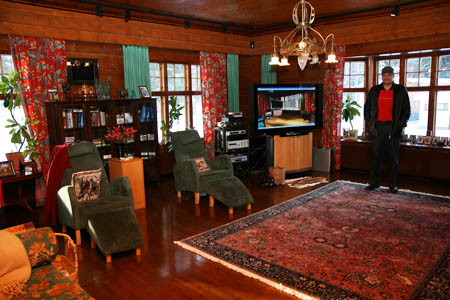
Juha Hulkko’s home in Oulu, Finland in realXtend and Juha at home in “real” life
I’ve been in the communications area all of my life and I’m still involved in that, but not actively anymore at the corporate level. I’m board member of a couple of companies, yes. But, when I stepped out from my position in my company one and a half years ago, I decided to explore my life long interest in the internet. I’ve been using the internet in my work, of course, but I’ve never had time really to explore the possibilities for innovation. I was just ordinary internet user. But, I was exploring and researching things and then I ran into Second Life.
I got quite interested very suddenly because I realized that this is something which is really important. I realized very soon that it is, and I still think it is, one of the greatest social innovations in decades. I could compare it to the internet when the internet started or when this wireless communication mobile phone boom started. It’s kind of same kind of revolution which will happen with virtual worlds. This is not technological innovation, it’s social innovation. This will make the World Wide Web interactive, social, so you can create your own interest groups there, and then combined with 3D and all the media things, it’s all this combination, it’s a huge thing.
But very soon I realized that Second Life was kind of hopeless for integrating real world applications. It was a closed world which means that 90% of the people I met, they wanted to isolate real life from Second Life. That was something I was thinking about quite a lot. I understand the motivation behind that, but somehow I realized that this is not really something with a big interest for me. I started to think very fast how this virtual world, in this case Second Life, really could be a kind of extension of real life.
Juha and Jussi outside their homes in RL and SL. Second Life picture by Noelani Lightfoot.
I understand completely why some people want to isolate their experience from real life. But I was thinking more of how I could utilize these virtual worlds for real life needs. I started to speak with people and when I meet new people I ask them one very simple question: What is your dream? Why are you in second life? And over 90% of the people answered me that their motivation is to explore and have fun. Look around, see different things and have fun.
And I said to those people, that’s great, you should do that. But, I also located some people who I saw that they had things they wanted to do connected to real life. They can be really simple things. For example, you are designing clothes in real life and you want to create them in Second Life and sell them to people and see what goods are good to sell there in Second Life, and in a real life shop. This is a very simple example. This is the way I started to find very eager active people and I made friends with them.
I also realized that one problem which I don’t personally like very much. In Second Life they are selling land to young people with very, very high prices. So I bought some islands there and I started to invite these young people to the island and said to them here is free land, do whatever you want. Of course there were some people who weren’t willing to do something useful. But I said OK but I hope that you would be part of our thing but regardless, if you get some sale wherever in real life or second life still I’m not asking any rent or any revenue.
I wanted people to do what they want but I wanted at the same time those people to be part of our Arkala community. Still things started to develop and we created a community of virtual friends called Third Eye. The idea behind Third Eye was we wanted to break the barrier between Second Life and Real Life. We started to think of different kinds of technical solution, e.g., sending sms between Second Life and “real†life. We can even control a huge radio station in real life from there (see picture below ). That’s the magic motivation for me. I have been in telecommunications, I have been an entrepreneur for 25 years so I have no business interest for myself. I just wanted to see can you really break these barriers.
We had these communication concepts we made a project for vanishing species. These animals are vanished from Real Life, e.g. The Chinese River Dolphin which is extinct. You can see it on our island and communicate with it. We wanted to show people what it means when we are killing animals, whole species, in Real Life. By seeing them here in Second Life we hope people will appreciate more what is being lost and start thinking.
When we called the Chinese River Dolphins made by Nicolas Sordello a student of Ecole Nationale Supérieur des Arts Décoratifs de Paris came to us. Picture by Noelani Lightfoot.
“Save the planet†sounds a naive approach, but behind it is a growing worry about the state of our planet. That is why my dream is to use Virtual Worlds as tools to enable worldwide open communication on environmental issues. Not communication dictated by any governments, big companies or any single environmental institute. All people and organizations have equal opportunity to create change and right to contribute and offer their opinions and share their solutions with other people who are interested on these issues. It is a very powerful tool, I believe. We simply should leave this planet behind in better condition to future generations, better than the conditions we were born into. We need to start the wheel turning in a good direction. It is our generations responsibility and legacy to future generations.
Kilpisjarvi – place of great beauty where Juha tries to spend as much time as possible
I have been in global business for many years but I like the people I have met in Second Life this is something completely different they do this for love and not just for money. But pretty soon I realized we need an open platform and it has to be scalable so that you can create your own virtual world on your laptop or desktop.
I found a group of young talented people. As you know we have much technical talent as you have met some of them from Admino and Ludocraft (see my interview with Tony Manninen of Ludocraft here). We have many people from wireless telecommunications, a big base of computer scientists, engineering. I approached these people as said that in 6 months time I wanted to have these things happen. And now we have done this server concept which is scalable up from one pc all the way up to a big ISP hosted platform, so it is following very much the basic structure of the WWW not the Linden model of the closed world.
I understand why they did this and they have done a lot with this model of micropayments. But for real life applications it is not so much how much people are selling virtual goods to each other but how companies are selling content and services from virtual world to real life people. That is more realXtend’s focus – real life applications. We don’t want to compete with Linden we want to coexist with Linden. RealXtend is a free platform so of course anyone can do what they want with it, but it was originally designed to serve real life needs.
Kilpisjarvi Reindeer
A tour of Arkala Island
Over the last few weeks I have been fortunate to meet many of the talented people who are part of the realXtend team (see my post here about Tony Maninnen of Ludocraft). It was a great delight to be show round by Prof Lunasea the Second Life avatar of Professor Fran̤ois Garnier of Ecole Nationale Sup̩rieur des Arts D̩coratifs de Paris who is doing some extradordinary work with his students on Arkala Рcheck it out both on Arkala Island and see their awesome films here.
A screenshot from a short film by de Grégoire PIERRE.
Spade Dagger the Second Life avatar of Tommi Hollström of Admino showed me some of the work Admino has been doing as the part of the research and development for the reaXtend project. Admino Ltd is a company established by two brothers, Hannu and Tommi Hollström. Company started in June 2003. In the beginning Admino was concentrating in ERP systems and Microsoft products. Admino Ltd was actually third business that the brothers were working together. Tommi show me the Second Life control center for Radio Arkala.
This is 3d user interface for a real ham radio in arkala radio station. The user can use real radio, change frequency, hear radio, and talk. This is an easy way give anyone chance to try it out. This was first project where we did to extend reality :-). But there are other talented people involved too. Arkala Island is an island of innovations.

Radio Arkala in Second Life and Real Life
Spade also showed me a project to sell mobile content using L$.
When the user buys content and types in a phone number he gets content directly to mobile phone. The benefit of this from a business point of view benefit is we don’t use visa or sms payment so we save about 30% mobile operator payment in Finland. Usually the operator takes about 30%. We also are also researching selling videos or renting videos.
With OpenSim server we can male better integration examples for mobile content selling systems. So we can use those databases directly and maintain preview pictures prices, product codes there. Now we have import all preview pictures to SL objects and maintain those here. Its a big problem when we have for example 10000 products.
But the good part about SL is that here is a global currency and it is good for micro payments.Our biggest problem now in SL is we cannot offer extranet or intranet solutions (we have lot ideas in that area), but
but most big companies won’t put their intranet to SL servers. So we need overall security and a global avatar server, DRM, payment integrations, paypal, itunet, ovi etc. We don’t need make own currency or payment. For example, if we make “3d interface” to itunes, we just need api to use itunes payment.
The Key Issue is the Avatar
Juha Hulkko: One important thing we saw was – not only did everything have to be open, but that the key issue for this was the avatar. You always have to generate a new avatar for a specific game/virtual world.
The rational behind our avatar server which we are going to publish tomorrow is that for human life for hundreds of thousands of years the interface for how people communicate with each other has evolved in a certain way. We speak to people a certain way, we have body language which we use when we communicate with each other. But during the last 30 years, thanks to Mr. Microsoft and some big companies, they have taught us to sit in front of screens and use computers in a very very certain way. You have to use menus and you have to have to try to figure out what is the reasoning behind this web page before you can buy something, or how you can find information. But we simply saw that why we should not try to reinvent the wheel because Mother Nature has already developed a human interface which we use in real life. And that’s why we decided that it’s time to create completely new avatar concepts.
So if you want to be in the World Wide Web in the future you have to be there and communicate with surroundings as much as possible in the same way you do in real life, because that’s something everybody knows, you don’t have to learn. Of course, children have to learn to speak. But to get back to the natural human interface is why we wanted to make this global avatar project.
We started from very basics. For example, we started to design the avatar for 220 bones. But this physical part is only very small fraction of human life. It’s like in human life you can see people but that is not everything. So we are adding a lot of new features like mimicry. It means if I’m sitting with my laptop I have a small camera here if I smile, my other person smiles. If I cry the avatar cries.
This is very simple example. But you know from artificial intelligence research there are many people in the world who are now looking at these kind of things and looking at how people really interact in real life. We try and make everything open technically so everybody can add new kinds of features to our avatar. For us really the basic idea is to make this kind of avatar platform that enables everybody, who wants to, to embed different kinds of things in this avatar. We are doing this to create a defacto standard for virtual worlds which is based on open interfaces so that people can do what they want with it.

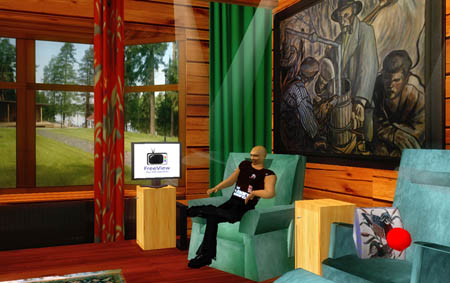
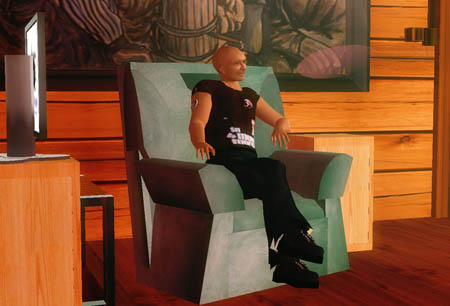
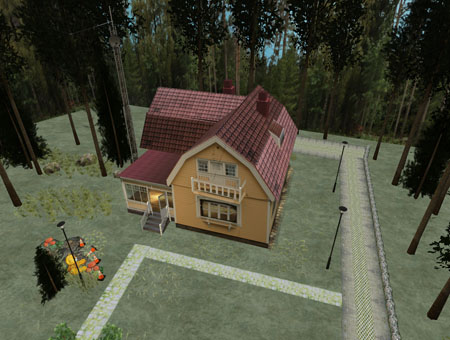
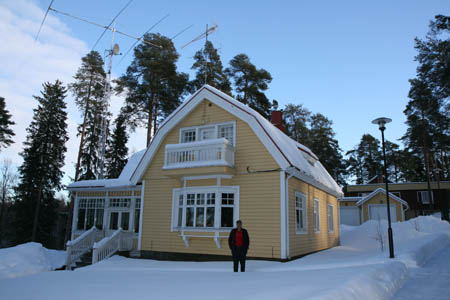
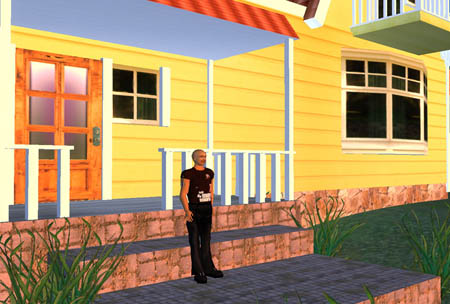
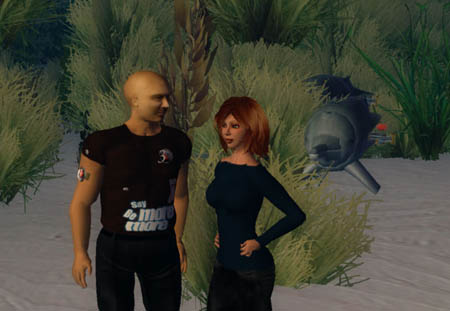
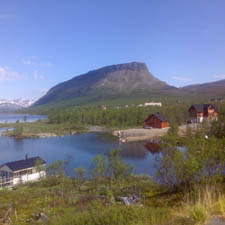
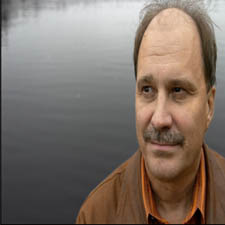

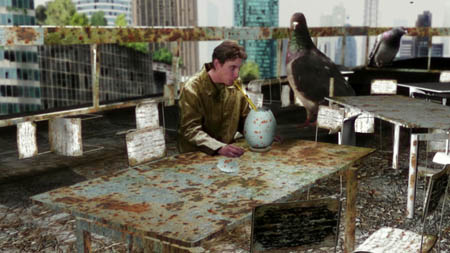
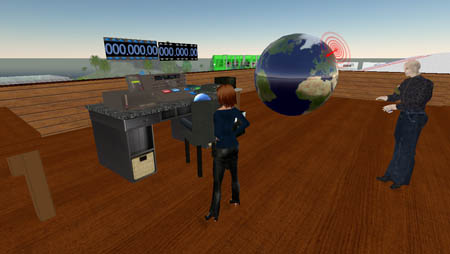
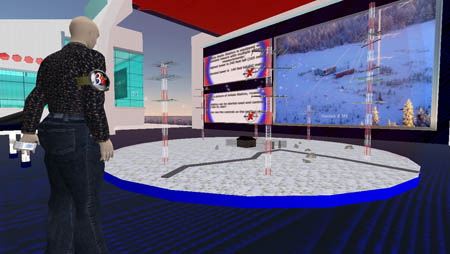
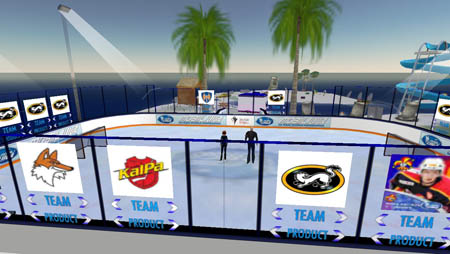
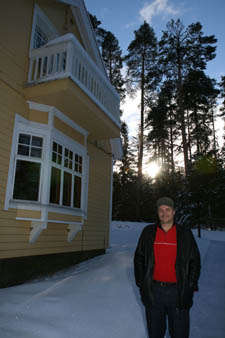
April 6th, 2008 at 2:03 pm
“So if you want to be in the World Wide Web in the future you have to be there and communicate with surroundings as much as possible in the same way you do in real life, because that’s something everybody knows, you don’t have to learn.”
Sure, and this reinforces the idea to enable same avatar usage in different applications.